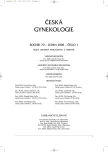-
Medical journals
- Career
Cystic Hypersecretory Carcinoma: Rare and Potentially Aggressive Variant of Intraductal Carcinoma of the Breast. Report of Five Cases
Authors: A. Skálová 1,4; A. Ryška 2; K. Kajo 3; Z. Kinkor 4
Authors‘ workplace: Šiklův patologicko-anatomický ústav LF UK, Plzeň, přednosta prof. MUDr. M. Michal 1; Fingerlandův ústav patologie FN a LF UK, Hradec Králové, přednosta prof. MUDr. I. Šteiner, CSc. 2; Ústav patol. anatomie LF UK a MFN, Martin, přednosta prof. MUDr. L. Plank, CSc. 3; Bioptická laboratoř, s. r. o., Plzeň, vedoucí prof. MUDr. A. Skálová, CSc. 4
Published in: Ceska Gynekol 2005; 70(1): 73-78
Category: Original Article
Overview
Objective:
To describe a poorly recognized histological and immunohistochemical features of cystic hypersecretory carcinoma of breast, including the overexpression of HER-2/neu protein and androgen receptors.Subject:
Review of clinical and pathological features of 5 cases of cystic hypersecretory carcinoma.Setting:
Private Bioptic Lab, Plzen and Department of Pathology, Charles University, Plzen.Subject and Methods:
Five cases of rare variant of intraductal carcinoma of the breast, so-called cystic hypersecretory carcinoma, are reported. The patients were females aged between 53 and 78 years (average 66,8 years). The size of the lesions ranged between 7 and 8 cm in largest dimension.Results:
In two cases, the development of high grade invasive ductal carcinoma was observed; in one additional case there was recurrence of high grade in situ carcinoma after three years. Strong overexpression of HER-2/neu protein was observed in three cases including those two with invasive component. Protein p53 was variably positive in all cases. Steroid receptor immunohistochemical study yielded variable results with only one case being positive for both estrogen and progesterone receptors. Interestingly, in most case (4/5) staining for androgen receptors was observed.Conclusion:
The importance of correct diagnosis of this potentially aggressive lesion is emphasized. The differential diagnosis of breast lesions with predominantly cystic growth pattern is discussed in detail.Key words:
breast, cystic ductal hypersecretory carcinoma, intraductal, in situ
Labels
Paediatric gynaecology Gynaecology and obstetrics Reproduction medicine
Article was published inCzech Gynaecology

2005 Issue 1-
All articles in this issue
- New Options in Pharmacological Treatment of Urge Urinary Incontinence in Women
- Importance of Registry of Aggregated Data on Women Giving Birth
- Analysis of Maternal Mortality in the Czech Republic in 2001
- Analysis of Present Diagnostic Methods of Intrapartal Fetal Hypoxia
- Contribution of Doppler Examination in Pregnancy at Risk of Alloimune Fetus Anemia
- Risk Factors of the 3rd and 4th Degree Tear during Delivery
- Birth Defects in the Czech Republic – Expected Incidence in the Coming Years
- Pelvic Exenteration
- Possibilities of Increased Radicality in Pelvic Exenteration
- Abdominal hysterectomy – Risk Factor in Development of Urinary Incontinence? Results of a Questionnaire Study
- MMP-26 mRNA and Estrogen Receptor Alpha Co-expression in Normal and Pathological Endometrium
- Protein bcl-2 Expression in the Mid-secretory Endometrium after Oral Estrogen-Progesterone Preparation
- Syndrome of Pseudomyxoma Peritonei – Description of Three Cases and Survey of the Problem
- Cystic Hypersecretory Carcinoma: Rare and Potentially Aggressive Variant of Intraductal Carcinoma of the Breast. Report of Five Cases
- Czech Gynaecology
- Journal archive
- Current issue
- Online only
- About the journal
Most read in this issue- Abdominal hysterectomy – Risk Factor in Development of Urinary Incontinence? Results of a Questionnaire Study
- Risk Factors of the 3rd and 4th Degree Tear during Delivery
- Syndrome of Pseudomyxoma Peritonei – Description of Three Cases and Survey of the Problem
- Contribution of Doppler Examination in Pregnancy at Risk of Alloimune Fetus Anemia
Login#ADS_BOTTOM_SCRIPTS#Forgotten passwordEnter the email address that you registered with. We will send you instructions on how to set a new password.
- Career

